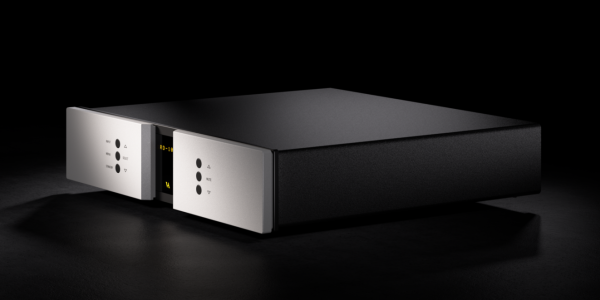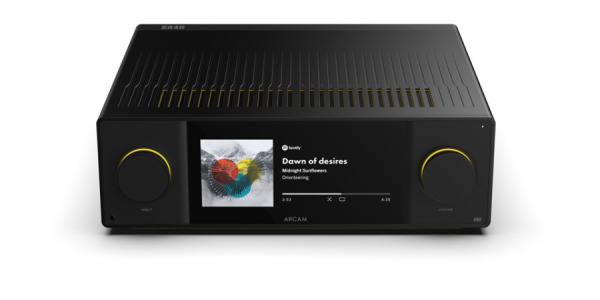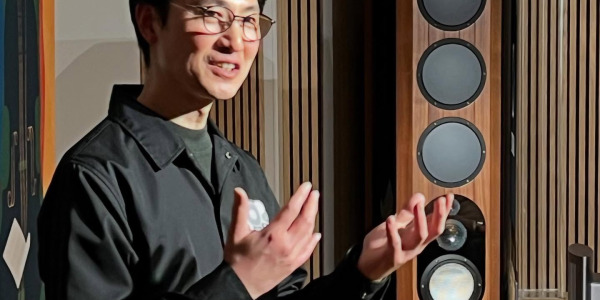Merason har de senaste åren varit mitt mest sålda märke när det gäller digitalomvandlare. Och det är välförtjänt. Merason briljerar med en väldigt realistisk scen, attack och tonal balans. Det är även en liten firma som brinner för vad de gör. Eldsjälen lyser verkligen igenom i alla Merasons dacar.
Klicka här för att komma till Merason Reuss på min hemsida
Läs testet i sin helhet här nedan.
The rolls Reuss of digital to analogue converters
TUE, 23/07/2024

Merason Reuss DAC
The name of Merason’s mid price DAC is pronounced royce I am told, but that takes some remembering. I have enjoyed both iterations of the Merason DAC1 which sits at the top of the range, especially the original with its stainless steel and acrylic casework, and the UK distributor is of the opinion that the Reuss is a slightly pared back version of that original model. Reuss is a slimline design as you can see but has all the relevant connections and a pair classic DAC chips in the form of the BurrBrown 1794A. This does limit the Reuss to PCM only inputs with a maximum 24-bit/192kHz data rate but I have never been a big fan of DSD nor massive data rates so it does what I need a digital to analogue converter to do. Fortunately most streamers can convert formats which allows you to play higher bit rates and DSD through a DAC like this.
Merason is a small Swiss brand that makes three digital to analogue converters and a power supply, the latter for the entry level Frerot model, they all use the same BurrBrown PCM converter chip (originally made in 2004 but revised to A status in 2015) because such things tend to sound better than their modern counterparts. Being able to process massive data rates and all manner of formats is convenient but hard to combine with the sort of analogue sound quality that older chips are capable of. In a fast moving world new is not always better as many a tube amp fan understands.

The Reuss uses separate voltage (I/V) converters and a Class A buffer prior to output via balanced or single ended connections. It’s worth noting that this is a fully balanced design rather than one which has had a pair of XLRs hooked up in parallel with the RCAs, this is achieved with four independent channels and the outputs of the two parallel converter chips. 12 power supplies are used in the circuit and the output stages have a dedicated linear supply with an oversized transformer. It’s a neatly laid out design with high quality fit and finish.
The USB, optical, coax and AES inputs are accessed with a selector switch on the front and a lock light lets you know that a signal has been detected by the chosen input, quite a useful feature if you are constantly changing sources and a reassurance even if you’re not. There is no volume control nor options to change filters or oversampling, the Reuss is very much a dedicated DAC where the only decision you need to make is what music to play. In practice the volume controls found on DACs are usually compromised and having the option to play with filters etc can leave you in a perpetual state of concern about whether the right one has been selected for a given piece of music.

Sound quality
The Reuss has the characteristic sound of Merason DACs, it is fast, agile and highly engaging. The tonal balance is very even handed and makes some other DACs sound a bit thick and blurred, but if you prefer a warmer, smoother sound then this might not be the converter for you. That said everything depends on the signal and the source providing it as well as the loudspeakers and amplification, the Reuss doesn’t have a thin balance but it doesn’t fudge the issue either, it tells it like it is. And it tells it in pretty compelling fashion.
For a start this is a subtle D/A converter, one that lets the source signal do the talking without exaggerating dynamics or timing, instead it delivers an awful lot of the subtleties in the signal and lets you hear into the recording. All of which means that you won’t hear its qualities without a reasonably transparent system, one that doesn’t add to nor change the sound. I got great results with a variety of sources including a Lumin U2 Mini streamer and a Mutec MC3+ reclocker, both fed by a Melco N10 server/streamer. Initially however I tried the DAC with a Michi X3 S2 streaming amplifier that while very powerful and smooth lacked a little in the vivacity department. Taking its digital output and feeding back an analogue one did the world of good, and while you would hope that this were the case the change was enough to make the entire system a whole lot more compelling.

Jumping to better amplification, Townshend Allegri Reference and Naim NAP 300, proved to be highly beneficial as one might hope, with both the thick gloopy hip hop of B.Y.O.B.’s eponymous album and the brilliant playing of Baden Powell’s Solitude on Guitar sounding very good indeed. The latter is an acoustic piece on guitar and double bass and which was produced with a vibrant, spirited live sound that was very easy to enjoy. As is often the case with high resolution electronics the Reuss is very good at letting you hear the quiet details such as reverb on acoustic instruments, this gives the end result a greater depth and makes the music sound more real. When combined with the excellent timing capabilities of this DAC it makes a good case for the analogue sound that its maker is seeking.
It was interesting to compare the Reuss with the SPL DAC that was reviewed recently, that is a less expensive (£2,500) and smaller device that has a distinctive sound as a result of its high operating voltage. The SPL has more power in the bass than most DACs but cannot match the openness and timing of the Reuss, which sounds more refined and involving by comparison. It doesn’t let heavier recordings bludgeon your ears by virtue of that timing skill. Timing is a strange thing, when it’s not good any component can sound as if it’s tonally wrong, frequently bad timing can result in a bright, forward sound. Change the timing and everything comes together, the tonal balance hasn’t changed but the fact that notes stop and start precisely when they should means that the music is more coherent and the tonal balance is no longer an issue.
I also contrasted different releases of a Steely Dan track where the Reuss made it clear that an SHM-CD sounded louder and flatter than a PT-SHM while the version on the Citizen compilation was also a bit louder, the SHM-CD ultimately being the better sounding of the three. I tried the same with Patricia Barber’s Subway Station #5 where an MFSL version timed better than a standard CD rip. It’s hard to know if these tracks came from the same original sources, probably not, but this DAC is nothing if not revealing. And that transparency results in some very special sound even with less than perfect recordings. Outkast’s Love Hater being a great example of a commercial release that is so well constructed and performed that it transcends the limitations of its production and blew me away via the Merason.

Reuss verdict
The Merason Reuss proved to be a highly engaging and revealing DAC with a variety of sources and loudspeakers in my system, it consistently made my digital files sound fresh and vivid in a fashion that is indeed more consistent with analogue sources than many of the alternatives. The price for this is limited format conversion capability but the formats that it does process so well are the ones that really matter, PCM at up to 192kHz covers 99.9999% of all original digital releases, probably more. Not for DSD purists then but a very appealing option for anyone that wants to hear the message in the music; the Reuss delivers regardless of what that message might be and draws you into the music without seeming to try.
Type: PCM only digital to analogue converter
Distortion THD+N: <0.015%
Signal to noise: 115dB
Digital inputs: USB 2.0, coax on RCA, optical on Toslink, AES on XLR
Wireless inputs: none
Analogue outputs: single ended RCA, balanced XLR
Maximum bit/sample rate: 24-bit/192kHz via USB
Output Voltage: 3V RMS balanced, 1.5V RMS single ended
DAC chip: 2x BurrBrown 1794A
Accessories: none
Dimensions HxWxD: 50 x 450 x 290mm
Weight: 4.2kg (12 lbs)
Warranty: 3 years
£4,950
Niedal Audio Lab
T +41 33 243 28 16
merason.ch
digital to analogue converter
Jason Kennedy




